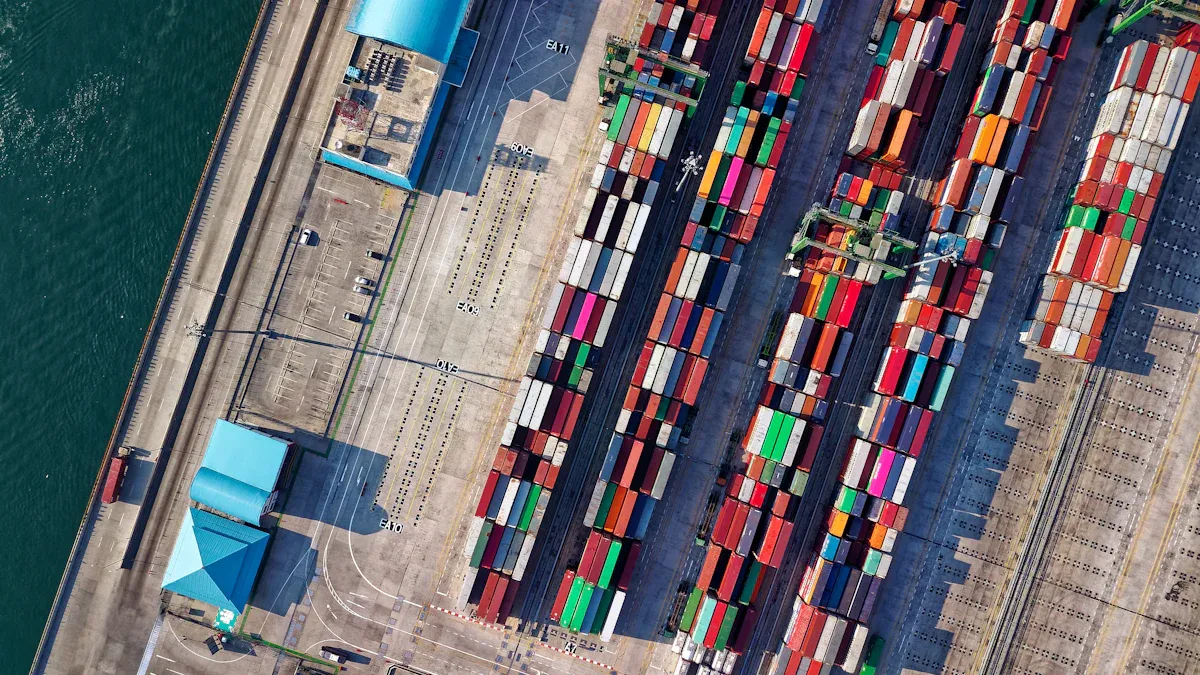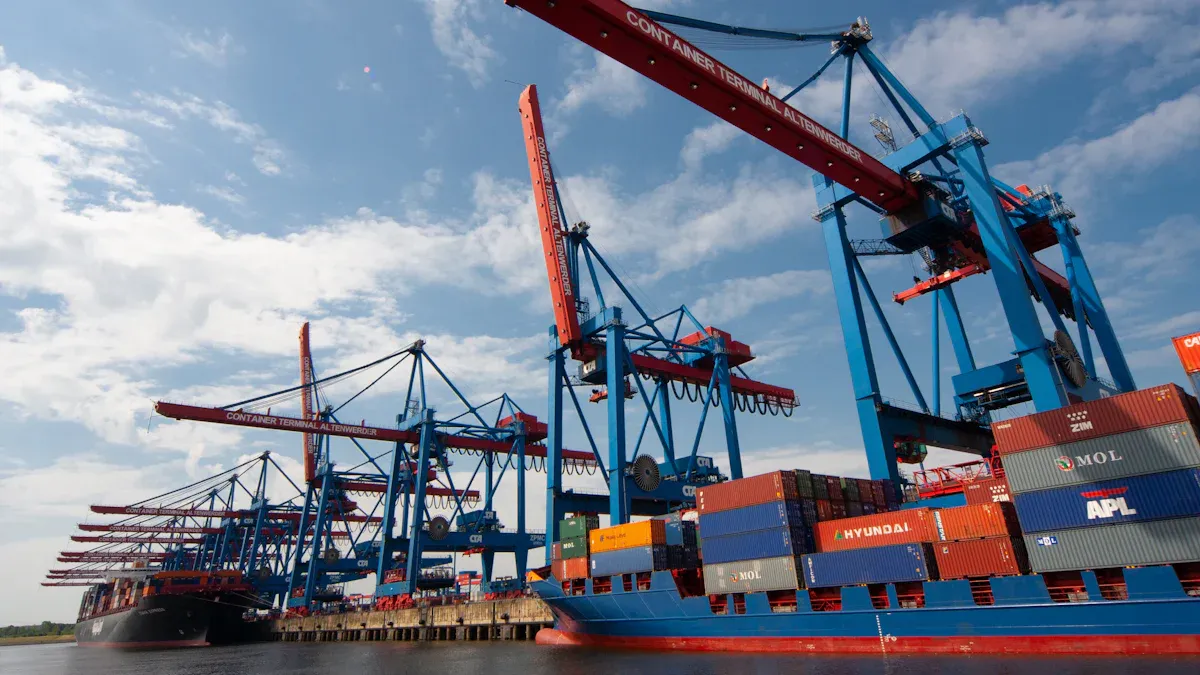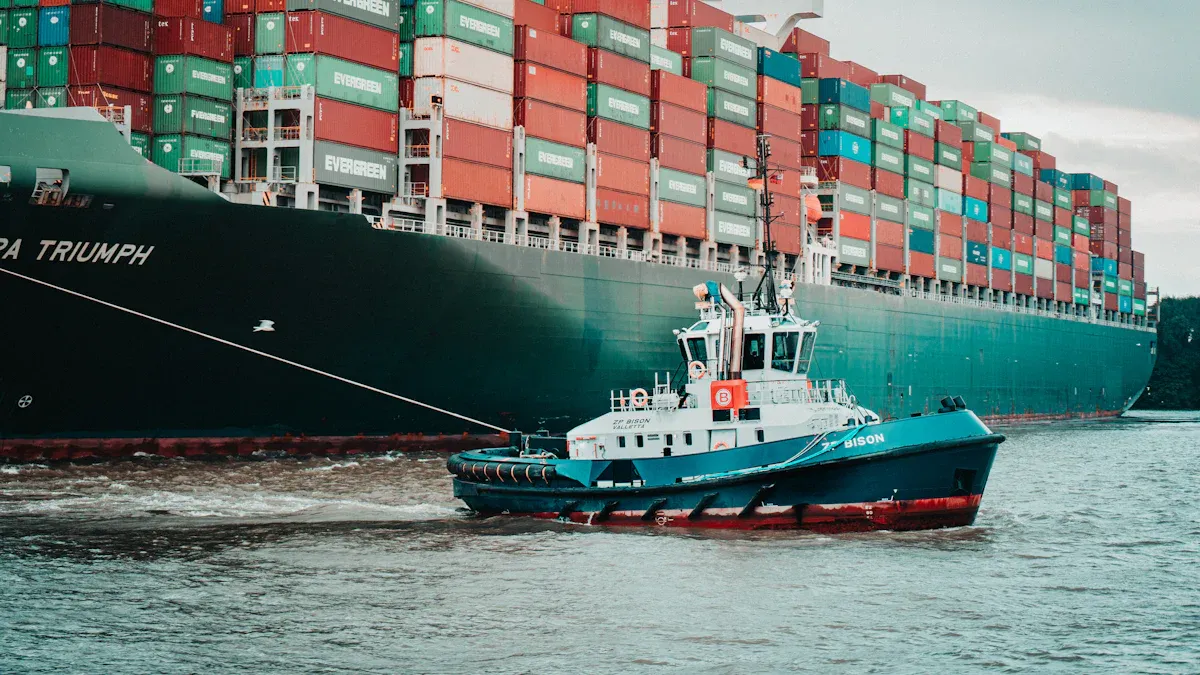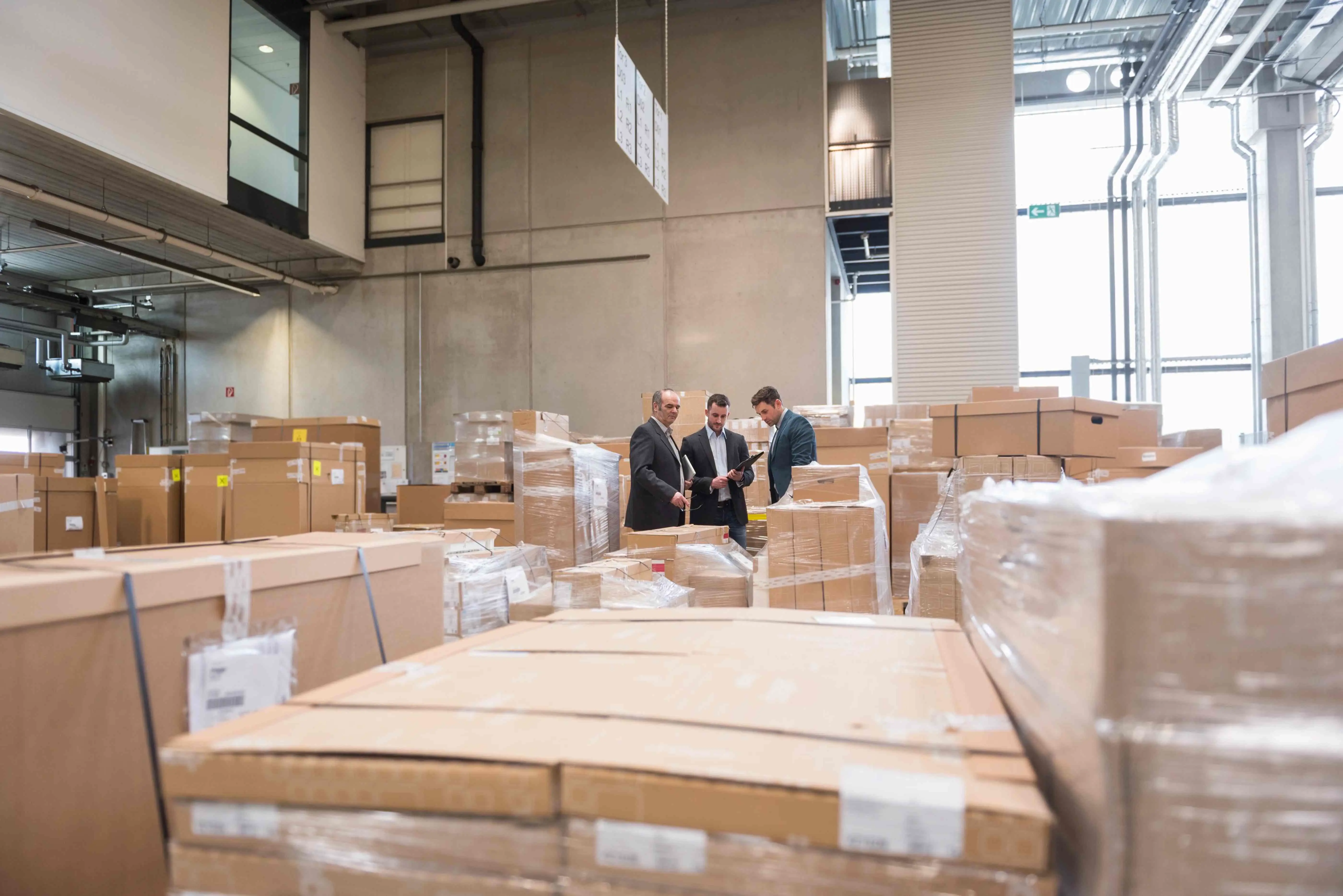Key Approaches to Improve Global Logistics Networks

Optimizing global logistics networks is key to staying competitive today. E-commerce and global supply chains need better logistics solutions. Research shows AI can cut costs by 15% and boost efficiency by 65%. Route planning saves 10-20% on fuel and ensures on-time deliveries.
Key Takeaways
Making logistics networks better can save 15% money and improve work by 65%. Use tools like AI and machines to make tasks easier.
Watching the supply chain in real-time stops problems and makes customers happy. Use tools like blockchain to share data safely.
Using green methods in logistics, like planning routes and eco-friendly packaging, cuts pollution and makes the brand look good.
Understanding Global Logistics Networks
What are global logistics networks?
Global logistics networks are systems that help move goods worldwide. These systems include parts that work together for smooth operations. Each part is important for keeping things running well and meeting customer needs.
Part | How It Helps |
|---|---|
Lowers costs and speeds up deliveries, making customers happy. | |
Transportation and Delivery | Moves goods quickly and cheaply, keeping products flowing smoothly. |
Inventory Management | Stops running out of stock or having too much, helping orders get filled. |
Technology and Data Use | Plans better routes and tracks inventory, improving performance. |
Supplier and Vendor Partnerships | Provides good-quality products, keeping operations steady. |
Customer Order Processes | Makes customers happy with fast and correct order deliveries. |
Rules and Risk Management | Avoids problems and follows safety and environmental rules. |
These parts work together to keep goods and services moving without problems.
Why logistics is important in global trade
Logistics is key to global trade and supply chains. It helps goods travel from factories to buyers, connecting different places. Here’s how logistics affects global trade:
Factor | Rank | Why It Matters |
|---|---|---|
1 | Most important for trade | |
Building Infrastructure | 2 | Affects supply chain success |
Attracting Investments | 3 | Less important but still helps |
Good logistics systems grow exports, improve infrastructure, and bring in investments. These things make supply chains stronger and help businesses compete globally.
Problems in improving supply networks
Fixing supply networks can be hard. Companies face these problems when trying to improve:
Balancing costs with good service is very important.
Collecting data helps make better choices.
Designing networks must match what the company needs.
Also, shipping costs have gone up by 20%, and customers want faster deliveries by 15%. Even with these problems, companies have cut delivery times by 15% on average. This shows that smart planning can make big improvements.
Key Strategies for Logistics Network Optimization

Using technology to improve global logistics
Technology helps make global logistics work better. Advanced tools can reduce mistakes and save time. Automation cuts down on manual work and boosts productivity. Real-time tracking helps deliveries arrive faster and improves operations. Blockchain keeps records safe and builds trust. The Internet of Things (IoT) helps plan routes and manage inventory using live data. Predictive analytics shows future demand, helping businesses adjust quickly. The table below shows how these technologies help:
Technology | How It Helps Logistics |
|---|---|
Automation | Speeds up work and reduces mistakes. |
Real-time Tracking | Makes deliveries faster and more efficient. |
Blockchain | Keeps records safe and builds trust. |
Internet of Things (IoT) | Plans routes and tracks inventory with live data. |
Predictive Analytics | Predicts future needs and market changes. |
Big Data Utilization | Shows customer habits and finds growth chances. |
Using these tools makes logistics networks better and gives businesses an edge.
Improving supply chain visibility and clarity
Seeing the supply chain clearly is very important. Real-time updates help track shipments and check inventory. This also helps fix problems early. Clear information builds trust and keeps customers happy. Tools like blockchain and cloud systems make sharing data easier. They also cut down on wasted time. With better visibility, businesses can make smarter choices and avoid risks. This helps keep the supply chain strong and matches business goals.
Making transportation and routes better
Good transportation planning is key to better logistics. Tools like Big Data Analytics find cheaper and faster routes. Using different transport methods, like trains and ships, saves money and time. IoT gives live updates to improve route planning. These methods lower fuel use and ensure deliveries are on time. Better transportation planning helps the whole logistics system work well.
Simplifying warehouse and inventory management
Managing warehouses and inventory well is very important. Automation and IoT give live updates on stock levels. This stops having too much or too little stock. Cloud systems help control inventory from one place. These tools make work faster and more accurate. They also save money and keep customers happy. Better warehouse and inventory management keeps the supply chain flexible and ready for changes.
Integrating Sustainability into Logistics Networks

Eco-friendly practices in logistics network optimization
Using eco-friendly methods can make logistics more sustainable. Route planning uses data to shorten trips and skip traffic. This saves fuel and cuts pollution. Sensors on vehicles help keep them running well. This improves efficiency and lowers emissions. Green fleet plans check if eco-friendly vehicles are a good choice. These steps help businesses go green while staying efficient.
Reducing carbon emissions in transportation
Transport causes a lot of CO2 pollution worldwide. In 2022, transport emissions rose by 3% compared to 2021. Air travel recovery caused this increase but emissions stayed below 2019 levels. To meet climate goals, transport emissions must drop 25% by 2030. Electric vehicles, better energy use, and smart policies can help. Businesses can use electric cars, plan routes better, and avoid extra trips.
Sustainable packaging and waste reduction strategies
Eco-friendly packaging helps make logistics greener. Using recyclable or biodegradable materials is better for the planet. Reusing boxes and cutting extra packaging reduces waste. Filling containers fully lowers trips and pollution. These ideas save resources and make logistics work smarter and cleaner.
Overcoming Implementation Challenges
Handling resistance to change in organizations
Change can be hard for many workers. Some may not like new systems or methods. This happens for a few reasons:
Losing control of familiar tasks.
Not knowing why changes are helpful.
Feeling attached to old ways.
Too many changes happening at once.
To fix this, talk clearly with your team. Show how changes make work easier and faster. Offer training to help them feel ready and confident. Get support from team leaders to encourage others to accept the changes.
Controlling costs and using resources wisely
Improving logistics needs smart money planning. You must balance spending now with future savings. For example, better supply networks can cut costs by 34.76%. They also reduce wasted resources by 15.6%. But, this needs good planning and smart use of resources.
Find areas to save money without lowering quality. Use tools like route and inventory planning to work better. Spend money where it helps the most. Check costs often and adjust plans to stay on budget.
Following international rules and laws
Global logistics must follow many rules in different places. Breaking rules can cause delays, fines, or legal trouble. To avoid this, learn about trade laws and customs rules.
Use tools that show real-time updates on rules. These tools help track shipments and manage paperwork. Work with experts to make following rules easier. By focusing on rules, you can avoid problems and keep customers happy.
Future Trends in Global Logistics Optimization
AI and machine learning in logistics network optimization
AI and machine learning are changing global logistics. These tools help make better choices using real-time data. Big companies like Amazon use AI to predict product demand. This ensures items are ready when customers need them. DHL uses machine learning to plan faster and cheaper delivery routes. AI also handles boring tasks, so workers can focus on big plans. Predictive tools guess future needs, helping manage stock and cut waste. Using AI makes logistics faster and more flexible.
Blockchain for supply chain transparency
Blockchain is improving supply chains by sharing data safely. It keeps records that cannot be changed, building trust. This reduces cheating and makes operations clearer. Studies show blockchain boosts supply chain efficiency and performance. For example, its effect on efficiency is rated at 0.358. Its impact on performance is rated at 0.376. Adding blockchain helps share data, improve processes, and keep customers happy.
Autonomous vehicles and drones in transportation
Self-driving vehicles and drones are changing deliveries. They make last-mile deliveries faster and cheaper. Companies like UPS test drones to deliver packages quickly. Self-driving trucks plan better routes and save fuel. These tools also reach places that are hard to access. Using these technologies helps businesses stay ahead in logistics.
Data analytics and predictive modeling for logistics
Data tools are key for better logistics. They study past and current data to find patterns. UPS saves $400 million yearly by using data to plan routes. Amazon uses similar tools to stock items customers want. These tools also find problems in supply chains. Fixing these issues makes operations smoother. Using data insights improves efficiency and helps businesses succeed.
JUSDA’s Role in Optimizing Global Logistics Networks
Using JusLink Intelligent Supply Chain for better logistics
JusLink Intelligent Supply Chain changes how logistics are managed. It shows real-time updates on shipments and inventory. You can track goods at every step. It spots risks early, so problems are fixed quickly. JusLink helps suppliers and manufacturers work together smoothly.
You can check delivery updates for orders on one platform. JusLink combines data from many logistics companies. It gives useful reports to make smarter choices. It also predicts stock needs to avoid waste and save money. By using JusLink, businesses can improve logistics and stay ahead.
How China-Europe Express Rail helps global logistics
The China-Europe Express Rail makes shipping faster and cheaper. It moves goods between China and Europe in 15-20 days. This is quicker than ships and costs less than planes. It works for many industries like electronics and clothing.
JUSDA helps with customs and keeps shipments on time. The rail also connects sea and rail routes, linking Asia to Europe. This system improves trade routes and gives businesses a strong shipping option.
Custom solutions for different industries
JUSDA creates logistics plans for different industries. IoT tools help track goods and fix problems fast. Sensors and GPS show where items are and keep them safe.
Blockchain makes processes faster and keeps data secure. Companies using blockchain save 15-35% on costs and speed up work by 30-60%. Data tools also improve warehouse and transport planning. These technologies help businesses make smart choices and keep supply chains strong.

JUSDA Solutions
To provide you with professional solutions and quotations.
Improving global logistics needs smart use of tools and ideas. Technology makes work faster, cuts delivery times, and keeps customers happy. Green methods save energy and lower pollution. Customer-focused plans build trust and keep people coming back.
Tracking shipments live turns problems into good experiences.
Working with online stores boosts sales.
Great service helps new businesses survive and grow.
JUSDA’s tools, like JusLink and the China-Europe Express Rail, give businesses an edge. These tools make supply chains better, save money, and improve how things run. Using these ideas can make your logistics stronger and help you succeed globally.
See Also
Discovering The Best Global Logistics Firms For Success
Five Cutting-Edge Strategies For Supply Chain Improvement
Transforming Future Logistics With AI In Supply Chains
Essential Techniques For Effective Supply Chain Optimization
Addressing Global Supply Chain Growth Challenges Effectively
